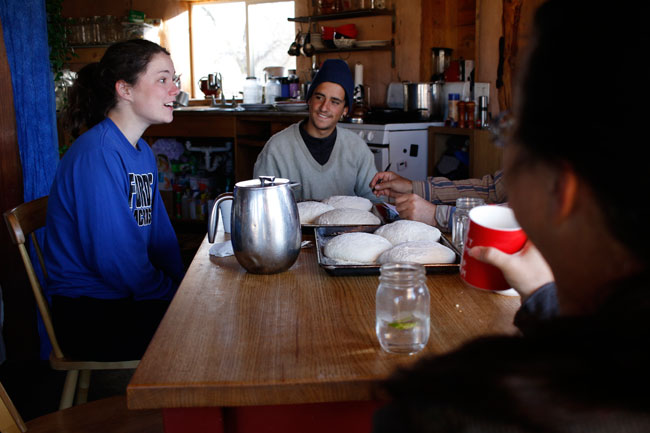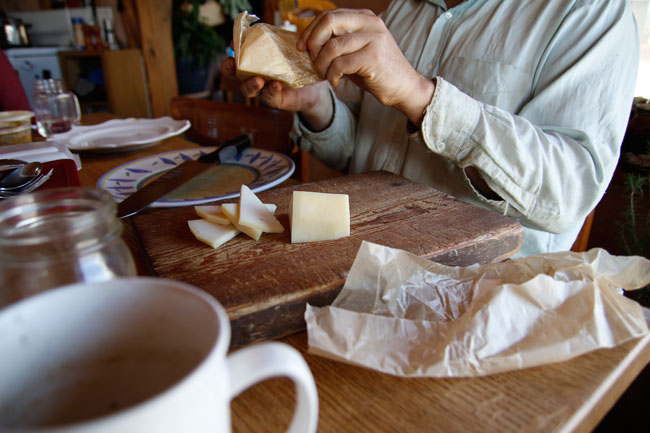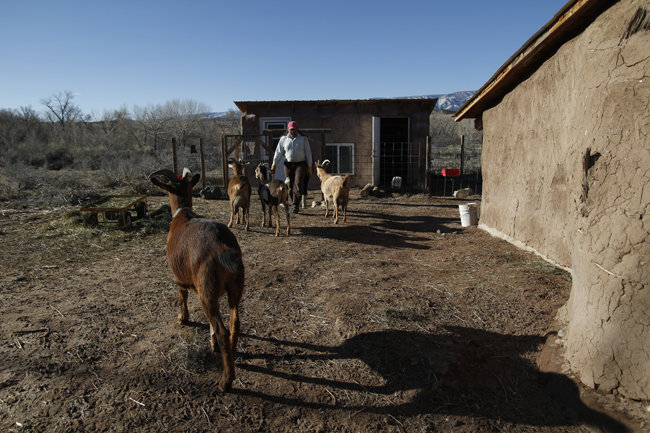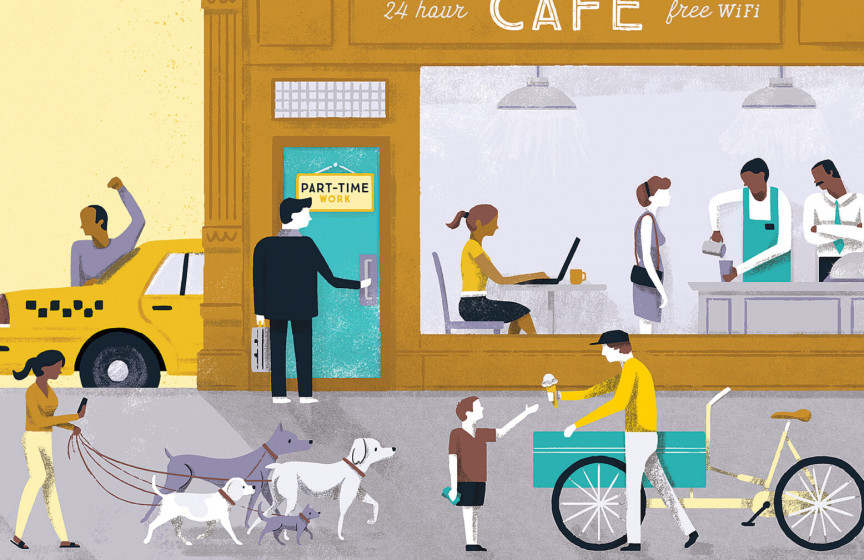The Gig Economy Issue: In Depth
- On a Remote Homestead, the Work You Do Is Not Just a Job—It’s Your Life
- Share

Mark Schneider and intern Cait Coyle harvest chives from the spring garden, still mostly covered against the early May chill, to mix with fresh goat cheese for farm share deliveries. Behind them are the Sangre de Cristo Mountains. All photos by Olga Kreimer.
On a Remote Homestead, the Work You Do Is Not Just a Job—It’s Your Life
Far from the 9-to-5, the work of building community can be a challenge when the cash economy is less relevant and volunteers are just passing through.
Mark Schneider and Val Phillips have never heard of the gig economy. Two hours from the nearest train stop and even farther from the coastal cities where companies like TaskRabbit and Postmates got their splashy starts, they live what could be considered a simple lifestyle, the opposite of the perpetually iPhone-adjacent city hustle. Their house, built by many hands out of straw bales and heated solely by southern sunlight in winter, stands in a thousand-year floodplain in Huerfano County, one of the poorest in Colorado. They’re the stewards of Shii Koeii (a name meaning “people’s water” in Jicarilla Apache), a creekside homestead now in its ninth year.
Smartphones are basically moot here. The internet and electric coffee grinder get turned off on gray, windless July days when battery power is low. The daily rhythm of feeding, milking, watering, planting, and harvesting could be determined by almanac. But the uncertainties that accompany the urban gig economy are a presence here too. Mark and Val opted out of the traditional 9-to-5 workforce to return to something like subsistence farming, but they rely on Medicaid and food stamps to stay solvent, despite working almost constantly in the high season.
Though the land feeds the goats and chickens, which in turn supply the surrounding community with eggs, produce, and four different kinds of goat cheese, a large part of the labor powering Shii Koeii is not homegrown at all. Beside Mark, Val, the goats, chickens, bees, and worms are intern farmers who come to provide the bartered labor force that keeps the place running.
I came to Shii Koeii four years ago, one of a handful of interns who arrived from around the country to learn about small-scale farming, study intentional community, and get dirt under our fingernails. The garden walls we built then are direly in need of patching. That’s more a sign of time than of neglect; built out of willow branches and a muddy stew of sand, clay, straw, and horse manure, they’re built to blend with the land, not overpower it.
Most interns find their way to Shii Koeii through the internet, on sites like WWOOF-USA (the national chapter of World Wide Opportunities on Organic Farms) that connect the dots between intern and farmer. Most, like I did, come from far away, eager to get their hands in the ground and see a part of the country where the roads have names instead of numbers. They trade farm labor for home-cooked meals and a place to sleep, and like the garden walls they patch and the seeds they nurture, they become part of the living landscape for as long as they stay.

Interns Cait Coyle and Christopher Cordeiro go over the day’s chores at the morning coffee meeting around 7:30 a.m. Mark prepared the bread loaves earlier that morning for afternoon farm share deliveries in the “nearby” town about 40 minutes away.
I had saved up for my trip, then spent my savings on visits to nearby cities, slices of pie from the cafe on market days, and one memorable outing to the rodeo. My funds ran out just as my real life called me back east; the start of the school year and a job waiting for me back in Brooklyn, New York, meant that my commitment was fleeting from the outset. It also meant that my months without an income were limited. You don’t need much cash to survive at Shii Koeii; the land provides piles of vegetables, Mark shapes loaves of bread from giant bulk bags of flour, and there’s a stash of shampoo left over from past interns. But those with consumer debt, medical expenses, or insufficient savings may be unable to make it work long-term.
Caitlin Fogarty, one of my fellow interns during the summer of 2012, had also saved in advance to make her way to Colorado from central Florida. She had health insurance through her mom’s employer and a cell phone bill around $20 a month on her parents’ family plan. “I didn’t really spend any money while I was at Shii Koeii,” she says, beyond an occasional cup of tea on day-off outings. “They’re kind of this microcosm in this crazy capitalist world,” she says of the farm. It’s a bucolic respite that wouldn’t be sustainable for her long-term, though. Mark and Val have asked her back, but she just can’t afford it.
“My health insurance keeps going up. Right now, it’s like $400 a month,” Caitlin says. A few years ago, she was diagnosed with multiple sclerosis, making access to care a priority consideration as she looks into possible future opportunities to live in an intentional community and continue small-scale farming. Even with subsidies, her medical expenses are high. “If I was in a place like [Shii Koeii], I’d have to have an outside job,” she says—an untenable option given the farm’s remote location and the intensity of the work required on site.
Mark and Val are generous with rides from the transit hubs two or three hours away, and they recently introduced a modest completion bonus to help departing interns on the next legs of their travels. Sometimes, they’re even able to help an intern pay their way to town. Shii Koeii’s nonprofit status also means that some student debts are eligible for deferment, opening the door to a bigger pool of interns. But the kind of financial support that an apprentice like Caitlin would need to stay long-term is still impossible, which means the door just isn’t open to everyone—and Mark and Val are left without the lasting partners they still hope to attract.

Two different kinds of raw cheddar are made from Shii Koeii goat milk.
With its built-in expiration date, my stay on the farm was not much different from the temporary gigs I pick up as a freelancer. It was just another piece of cobbling together a living. In self-employment, self-sufficiency free of any Office Space overlords is held up as the prize and the principle. Although Val and Mark are similarly building a way out of the rat race, their approach aims for a new paradigm altogether.
For example, self-sufficiency isn’t one of their goals. In fact, “there is no such thing,” says Val. “You are always interdependent with other people, with other life, with other beings. The question is, who do you want to be interdependent with?” Their answer is their community. Their budget relies on donations to break even every year, a conscious choice that’s both pragmatic and deeply aligned with their view of the world. Asking annually for community investment is a radical move, relying on generosity to survive. It’s “a spiritual practice of being vulnerable enough to have to ask for help,” says Val. “And to ask your community to believe in you.”
The farmers market they started five years ago is thriving, with more vendors every season and a committed customer base. Their customers come to market to stock up on heirloom tomatoes and goat “farmesan” cheese, then stop by the farm to take the goats to pasture when there aren’t enough farmer hands on deck. This is what community support looks like.
But it’s not only community support that helps sustain Shii Koeii. Mark and Val’s minimal income qualifies them for government aid like SNAP benefits, which pay for food that the land doesn’t provide. Those benefits allow them to contribute more to the community by making cash available to purchase high-quality local meat, for example, which supports local ranchers—“keeping the money in the county,” says Val.
Government aid also means that funds are available for Shii Koeii’s direct initiatives to make good food available to people regardless of their means. They offer two-for-one produce and protein deals for low-income customers and are set up to accept payment in SNAP benefits at the market. In a region where the median household income hovers near $33,000, these incremental measures are part of the slow work of expanding food access and growing lasting connections.
Despite the long-term investment and commitment necessary for growing food and community, life at the farm is attended by many of the same uncertainties that plague gig economy job hoppers. Mark and Val have no retirement plan, no fancy health insurance, no guarantees that the land that sustains them now will continue to do so for the next 40 years. To an outsider, the facts might seem frightening: With a $45 a month allowance and a plan to eventually sign over their deed to a nonprofit (once the legal entities are all in order), Mark and Val have committed themselves to poverty-level wages and no financial fallback plan.
If you ask them, though, these problems are not problems at all. Health insurance? Though they’re enrolled in Medicaid, they prefer alternative medicine and—Mark points to the table where we’re eating dinner—kale. Retirement? They trust the community they’re building to take care of them the way they want to take care of their elders, though so far no one is committed to staying on beyond a season. In place of retirement plans and health insurance, Mark and Val have chosen to rely on people. “For us, the contingency plan was always community,” says Val.
That’s why it’s so painful when the gig mentality intrudes. With a few stray bad apple exceptions, Val says that their interns have been thoughtful, collaborative, kind, adept—and every one this year has cut their stay short or, in some cases, not shown up at all.

Mark works in front of the milking shed with goats Cholla Chamisa Luna and Piñon. Both barns were built using straw bales.
The revolving door of help can make long-term planning for projects, like a cheese cave and added living space, tenuous at best. But in some ways, the pattern of truncated commitments is not surprising. The remote farm, approached by unpaved roads pitted with cattle guards, is hard to imagine for someone who hasn’t been there. Interns accustomed to light pollution might marvel at the starscape that stretches all the way down to the horizon, but they may not know ahead of time how stir-crazy they’ll feel in such a spot, how much they’ll miss their homes, or even how little they like farming. It’s a big question mark for a lot of well-meaning visitors, and when technology all but encourages last-minute cop-outs with a text or the tap of an app, that attitude can carry over to farm life.
I’ve been the one to bail sometimes too. When a commitment made in good faith has turned into more than I could offer, I’ve chosen my own well-being over my word, even while more than a little conflicted. For young people who have grown up in a time of few guarantees, it’s not intentional flakiness that drives such behavior but the sense that no one else will care about their needs as much as they do. It can feel like a fine line between being unreliable and taking care of oneself when no one else will.
Paradoxically, the intensity of farm life may reinforce the mentality that makes it easy for interns to bail. The greens and the goats don’t have time for gradual introductions, especially in the high season. Arriving at Shii Koeii, interns bypass the slow process of building long-term community and jump immediately into intimacy. After such a rapid transition from stranger to local, interns may feel that a sudden departure is just as easy. The short-term contracts of modern gig employment—easily made and easily broken—don’t exactly lend themselves to the kind of deeply rooted community that Mark and Val are building.
Still, even with its uncertainties, the land provides security for Mark and Val in a way that urban living never did. “I grow the same food. The seasons come and go. Nothing dramatically changes for me, and it’s very familiar, and I really like it,” says Mark.
The deep roots the farmers have been nurturing are apparent all over, from the goat share members who take the goats to graze one busy morning to the fried egg sandwiches Mark serves them for lunch: top-to-bottom homemade. “It’s farm table,” he jokes. “We don’t even need the ‘to.’”

